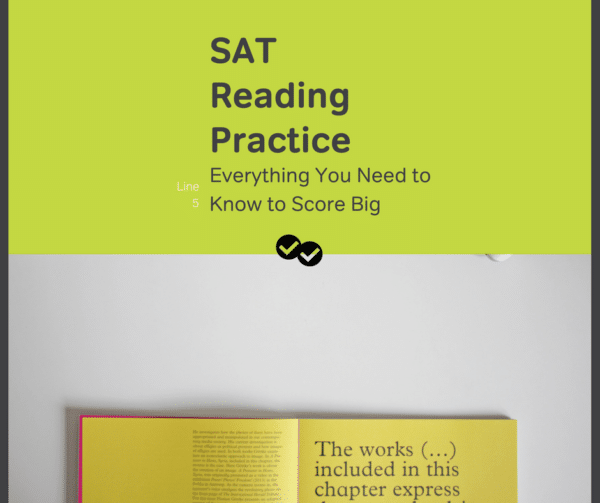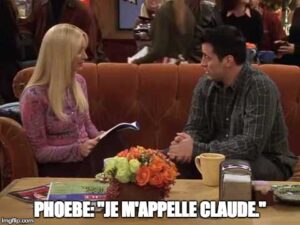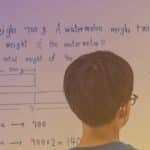
For a lot of students, sitting down for the official SAT and flipping open the booklet is a bit of an anxiety-provoking scenario. The one thing that’ll help you more than anything else on SAT Reading… is SAT reading practice. We’re going to compare our best SAT reading tips to the show, Friends, so you might also want to brush up on your Friends knowledge in order for this to make sense!
SAT Reading Practice: What Beginners Need to Know (AKA Season 1)
Know What to Expect
Okay, we may love them, but episodes about those comical New Yorkers really did have a formula (and it got increasingly obvious after all those seasons!). Bad news for Friends, but great news on the SAT! Once you get used to the pattern of the SAT Reading test…guess what? It’s not going to change! So download an SAT practice test now, take a look at what you’ll encounter on test day, and settle in. It’s a standardized test—and that’s a good thing!
Know the Question Types
The fact that the SAT Reading test uses the same format every single time is really helpful for clever students. As you learn more about the test, you’ll get to see that there are a limited number of question types. Work on identifying them during your SAT Reading practice and look for patterns. For example, when you see “In context, [word] most nearly means…” you’re probably dealing with a “Words in Context” problem, and you’ll want to go back to the sentence to make your own vocabulary prediction before plugging in the answer options. Similarly, a “Which sentence best supports…” question stem is a “Command of Evidence” problem, and you’ll want to look at your answer to the previous question first and consider how you got to the answer before you move forward with this one. Once you master these types of patterns, you’re golden!
Read the Questions Carefully
Just because you know what to expect generally doesn’t mean you should get careless when it comes to the particulars! You’ll be amazed at the difference one little word (like “NOT” or “EXCEPT”) can make to your score. For example, “The author would agree with each of the following statements EXCEPT…” has a very different answer than “The author would agree with which of the following statements?”
Similarly, “Which of the following statements does the author NOT use as support for her claim that…” is going to have a different response than the question, “Which of the following statements does the author use as support for her claim that…”
Commit
If Friends could go on for so long (10 seasons, people!), you can definitely devote a few hours a week to working on SAT Reading practice for a few months. Don’t think of it as obsessive practicing. Think of it as binge-watching the SAT.
What might that look like? If you have three evenings a week set aside for SAT study, consider devoting one of them to SAT Reading—and, of course, a Saturday morning to an SAT practice test!
Not sure how to make this work in your schedule? Here are some awesome SAT study schedules to help you out.
- The Three-Day SAT Study Guide
- The One-Week SAT Study Guide
- The One Month SAT Study Guide
- The Two Month SAT Study Guide
- The Three Month SAT Study Guide
- The Six Month SAT Study Guide
SAT Reading Practice: What Improvers Need to Know (AKA Season 5)
Know the Passage Types
Now that you’re familiar with the types of questions you’ll find during SAT Reading practice, it’s time to get familiar with the types of passages you’ll see, as well. The passages, of course, will change every time, but you can expect to see the same types of passages on each test: U.S. and World Literature (1 passage), History/Social Studies (2 passages), and Science (2 passages). You’ll soon notice that there’s also a paired passage, and it always takes the place of one of the History/Social Studies or Science single passages. Why is it important to know the passage types? As you get closer to your official test, you’ll need to know what to do if you start running out of time. By approaching your favorite/best passage types first, you maximize your chances of a great score.
Know the Wrong Answer Types
SAT practice questions will help you master this skill. You’ll see, as you go along, that the wrong answers to a question start to take on patterns, too. Sometimes they’ll be slightly exaggerated, or answering the opposite question, or only vaguely related to the passage. A lot of the time, certain wrong answer choices will appear with certain problem types. For example, get used to seeing opinions swapped in the wrong answers for paired passages! Of course, it’s a big waste of time to label every wrong answer you see (particularly on test day), but it is helpful to think like the test-makers!
Charts and Graphs


You’re not Joey going into an audition. You actually need to have these skills—and they are skills that can be developed! As you work on SAT Reading practice, make sure not to skim over those visual stimuli. It’s vital to study the charts and graphs you’ll see on SAT Reading differently than the data you’ll see on SAT Math.
Here, practice looking at data in tandem with the text. As you practice, ask yourself a series of questions about what you’re seeing:
- [If present] What does the x-axis represent? What does the y-axis represent?
- What relationships does this visual show?
- What part of the text most closely relates to the chart or graph?
- Does the chart/graph support the text? Contradict it? Provide additional information to support a point?
- What information does the chart or graph NOT show that would be useful in this context?
You’ll find that familiarizing yourself with the data right away can get you big points on the official exam!
Find the Right Support
Another question type that’s particular to the “new” (post-2016) SAT Reading section is the line reference question. As you work through practice questions, you’ll see a lot of these: they ask you which lines best support the answer to the previous question. Of course, if you got the previous question wrong, these become a whole lot harder. The more you see these questions, though, the easier getting them right will become.
SAT Reading Practice: What Masters Need to Know (AKA IS ROSS GOING TO GET TO THE AIRPORT IN TIME?)
Pick Your Favorite Passages
Nobody’s making you watch those weird episodes where (fifteen-year-old spoiler alert?) Joey and Rachel get together for no apparent reason. Skip ’em! You can come back later, after you’ve watched some more Chandler and Monica awesomeness. Same thing goes for SAT Reading practice: by now, you know what passage types you’re best at, and which you like the most (those coincidentally often happen to be the same passage types). Nobody’s making you do them in order! Pick your favorites and start there. It’ll put you in a better frame of mind—and, if you don’t get to all the questions in time, you’ll have had a better chance of answering the questions you did get to correctly.
Read, All the Time, a Lot (and Don’t Skip the Science!)
Let’s face it: out of all the friends, Ross is probably the one you’d least like to hang out with (I’m not saying you don’t want to hang out with him, just that the others would be more fun). But you have to have him in the mix! Just like the resident scientist on Friends, the more science you read in everyday life, the more palatable it becomes. For a lot of students, the science passages on SAT Reading are their least favorite, but skimming through Scientific American every now and again can really give you a leg up.
Based on your Netflix queue, you might also enjoy…
It can be hard to know where to start with that extra reading, so we’ve made a list for you. And if you’re worried about the other SAT sections, take a deep breath, because we’ve also put together posts on how to get the best SAT Writing and Language Practice and SAT Math Practice. Enjoy!
Next Week, on SAT Reading Practice…
Want to check out the new SAT practice test but don’t have time at the moment? No problem! Go ahead and download it for later, then take a peek at our mini-quiz here to get a preview of what’s to come. Answers and explanations below!
Excerpt from Rachel Ehrenberg’s The Facts Behind the Frack, from an issue of Science News.
Hydraulic fracturing, or fracking, wrenches open rock deep beneath the Earth’s surface, freeing the natural gas that’s trapped inside. (1) Proponents argue that fracking-related gas recovery is a game changer, a bridge to the renewable energy landscape of the future. (2) The gas, primarily methane, is cheap and relatively clean. (3) Because America is brimful of the stuff, harvesting the fuel via fracking could provide the country jobs and reduce its dependence on foreign sources of energy. (4)
But along with these promises have come alarming local incidents and national reports of blowouts, contamination and earthquakes. (5) Fracking opponents contend that the process poisons air and drinking water and may make people sick. (6) Fears that fracking companies are operating in a Wild West environment with little regulation have prompted political action. (7) Legislation banning the process has been considered but is now on hold in California. (8) New York — which sits atop a giant natural gas reserve — has a statewide fracking moratorium; pending policies would allow the process only where local officials support it. (9)
SAT Reading Practice Question 1
The main purpose of the passage is to…
A. consider investing in an energy company that will create new jobs through fracking.
B. argue in favor of new legislation that restricts fracking in certain regions.
C. present an analysis of data that proves the harmful effects of fracking.
D. explore the circumstances that have led to legislation regarding energy sources.
(answers below)
SAT Reading Practice Question 2
The author argues that fracking…
A. is the best long term energy resource option.
B. will completely change the energy industry.
C. needs an overhaul to best meet energy production needs.
D. does not need to be addressed seriously.
(answer below)
SAT Reading Practice Question 3
Which choice provides the best evidence for the answer to the previous question?
A. Sentence 2 (“Proponents…future.”)
B. Sentence 4 (“Because…energy.”)
C. Sentence 7 (“Fears…action.”)
D. Sentence 9 (“New York…support it.”)
(answer below)
Question 1 Answer
The correct option is D. The author mentions that fracking creates new jobs, but does not give details about investing in such a company, so Option A is incorrect. While the author mentions a few harmful effects of fracking, Option C is incorrect because she does not provide or closely analyze specific data. Option B and Option D both mention legislation, but Option B suggests that the author has a biased point of view, when the author actually presents both pro and con sides of a debate. The author includes both positive and negative effects of fracking, leading her into a discussion of the legal issues surrounding fracking, making Option D the best choice.
Question 2 Answer
Option B is the best answer. While the author mentions the “energy landscape of the future,” she does not claim that fracking is the best option for that future, so Option A is incorrect. She does, however, mention that that “fracking-related gas recovery is a game changer.” The rest of the passage details both sides of the fracking debate, showing that changes are already happening within the energy resource industry (Option B). The author mentions that the lack of regulation has led to political action, but we don’t know whether an overhaul will actually affect energy production, so Option C is incorrect. Finally, Option D is incorrect, because examples like pollution and earthquakes show that the fracking debate does need to be taken seriously.
Question 3 Answer
Option B is the correct answer, because it shows that fracking is changing the future of the industry. None of the other sentences support the correct answer to Practice Question 2.
Note: On the SAT, the individual sentences won’t be numbered; instead, you’ll see line numbers beside the passage. Sometimes multiple sentences, or just a fragment of a sentence, might be included in an answer choice. BUT you will see this formatting, with the beginning and end of the quoted lines in parenthesis.







Leave a Reply